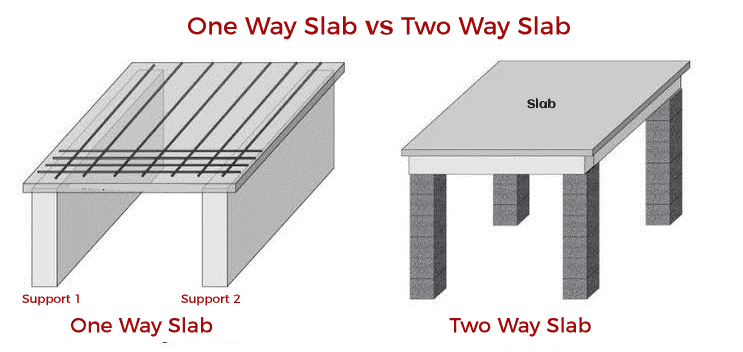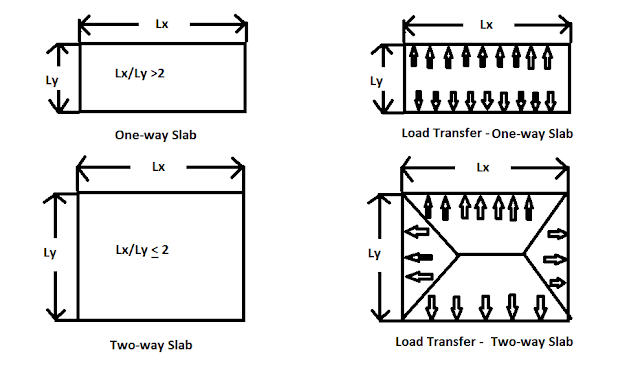
Top 5 Essential Differences: What is One Way and Two Way Slab? Formulas
Introduction: what is one way and two way slab?
Want to know detailed information about what is one way and two way slab and how to calculate one way and two way slab? Read the complete blog, You’re going to be genius in this topic.
In the realm of construction engineering, the significance of slabs cannot be overstated. These horizontal surfaces form the backbone of structures, providing support and stability. Among the various types of slabs, one-way and two-way slabs stand out for their unique characteristics and design considerations.
Let’s embark on a detailed exploration of what is one way and two way slab and these essential structural elements, understanding their differences, calculation formulas, design considerations, advantages, and limitations.
Understanding One-Way Slabs: what is one way and two way slab?
One-way slabs, characterised by a length-to-breadth ratio greater than two, are designed to support loads primarily in one direction. These slabs find application in structures with elongated spans, such as residential buildings, bridges, and pavements.
The structural behaviour of one-way slabs involves bending predominantly in one direction, influencing the distribution of loads and reinforcement requirements. Engineers must carefully consider factors like live load intensity, dead load calculations, and reinforcement detailing to ensure the optimal performance and safety of one-way slabs.
Exploring Two-Way Slabs: what is one way and two way slab?
In contrast, two-way slabs are engineered to support loads along two directions, making them suitable for structures with square or rectangular shapes. These slabs distribute loads more evenly along both spans, offering enhanced stability and load-bearing capacity.
The design of two-way slabs involves considerations such as moment coefficients, corner reinforcements, and load distribution factors. By understanding the nuances of two-way slab design, engineers can create structures that withstand varying loading conditions and maintain structural integrity over time.

One way slab and two way slab difference:
The distinction between one-way and two-way slabs lies in their structural behavior and load distribution patterns. One-way slabs primarily bend in one direction, while two-way slabs exhibit bending in both directions.
This fundamental difference influences the reinforcement requirements, design complexity, and overall performance of the slabs under different loading scenarios. By comprehensively understanding these differences, engineers can tailor their design approach to meet the specific needs of each type of slab, ensuring structural efficiency and safety.
One way slab and two way slab formula:
Understanding the design principles for slabs is crucial in structural engineering, with one way and two way slabs being common structural elements in buildings. Each type has its own set of design considerations and formulas.
For a one way slab, the design revolves around spanning in one direction, usually supported only on two opposite sides. To calculate one way slab formula it includes parameters such as load, span length, and material properties like concrete strength and steel reinforcement yield strength.
Engineers employ flexural design principles, considering factors such as moment distribution and deflection limits to ensure the slab can safely support the intended loads.
Two way slabs, on the other hand, distribute loads in both directions, necessitating more intricate calculations. Formulas for two way slabs take into account factors like slab size, spacing and diameter of reinforcement bars, and support conditions.
Engineers often use methods such as the yield line theory or the direct design method to determine the required reinforcement and thickness of the slab. Accurate calculation and attention to detail are paramount for both one way and two way slabs to ensure structural integrity and safety.
By understanding and applying these formulas accurately, engineers can ensure the structural integrity and safety of buildings, meeting the necessary design standards and regulations. Whether it’s a one way or two way slab, meticulous calculation and attention to detail are paramount to creating robust and durable structures.
Design Considerations and Pitfalls:
Several factors influence the design of slabs, including material properties, span lengths, and load conditions. Engineers must carefully consider these factors to determine the appropriate thickness, reinforcement spacing, and deflection limits for optimal performance.
However, common pitfalls in slab design, such as underestimating loads or neglecting deflection limits, can compromise the structural integrity and safety of the final construct. By addressing these design considerations and avoiding potential pitfalls, engineers can create robust and durable slab structures that meet industry standards and regulatory requirements.

Advantages and Disadvantages of One-Way and Two-Way Slabs:
One-way slabs offer advantages in terms of cost-effectiveness and simplicity, making them ideal for structures with long spans in one direction. On the other hand, two-way slabs provide better load distribution and are suitable for structures with irregular shapes.
Despite their advantages, each type of slab has its limitations, such as span capacity restrictions for one-way slabs and increased complexity in design for two-way slabs. By weighing the advantages and disadvantages of each type, engineers can make informed decisions during the design and construction phases, ensuring the structural integrity and performance of slab structures.
Conclusion: What is one way and two way slab?
In conclusion, the intricate world of one-way and two-way slabs offers a wealth of knowledge and design considerations for engineers and architects. By understanding the differences between these essential structural elements, mastering calculation formulas, and navigating design complexities, professionals can create robust and efficient slab structures that meet the demands of modern construction projects.
Through detailed exploration, comprehensive analysis, and practical insights, this guide aims to empower readers with the knowledge and expertise needed to excel in the design and implementation of one-way and two-way slabs in the dynamic field of construction engineering.
FAQ
Start with a brief introduction to explain the purpose of the FAQ page and how it can assist visitors.
One-way slabs primarily bear loads in a single direction, while two-way slabs distribute loads in both longitudinal and transverse directions. This difference in load distribution influences their support and reinforcement configurations.
The Coefficient Method simplifies two-way slab design by computing moments using predetermined coefficients. These coefficients consider factors like support conditions, span ratios, and types of loading, streamlining the design process for engineers.
Corner reinforcements in two-way slabs serve to counteract torsional stresses arising from uneven moments at slab corners. Adhering to ACI provisions ensures that these reinforcements are appropriately sized and spaced, maintaining structural integrity.
Flat slabs offer advantages such as aesthetic appeal, enhanced lighting, fire resistance, and simplified construction without beams. However, they also pose challenges like susceptibility to punching shear and potential pancake failure during seismic events.
Determining the minimum depth of a one-way slab involves considering deflection criteria to prevent excessive vibrations under load. Balancing depth and reinforcement can optimise costs while ensuring structural performance and safety.
Can't Find What you are looking for?
Tell us about your choice here!









